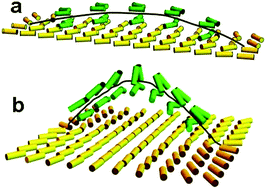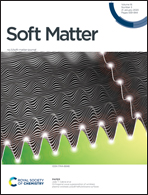Electric field-induced crossover from 3D to 2D topological defects in a nematic liquid crystal: experimental verification
Abstract
A substrate was patterned with two pairs of half-integer strength topological defects, (+1/2, +1/2) and (+1/2, −1/2). In a sufficiently thick cell, a disclination line runs in an arch above the substrate connecting the two half integer defects within each pair. The director around the disclination line for the like-sign pair must rotate in 3D, whereas for the opposite-sign defect pair the director lies in the xy-plane parallel to the substrate. For a negative dielectric anisotropy nematic, an electric field applied normal to the substrate drives the director into the xy-plane, forcing the arch of the disclination line of the like-sign pair to become extended along the z-axis. For sufficiently large field the arch splits, resulting in two nearly parallel disclination lines traversing the cell from one substrate to the other. The opposite-sign defect pair is largely unaffected by the electric field as the director already lies in the xy-plane. Experimental results are presented, which are consistent with numerical simulations.



 Please wait while we load your content...
Please wait while we load your content...